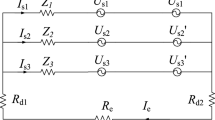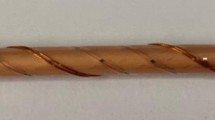Abstract
Cable containing two semiconductor screens has higher influence of the screen on line constants and wave propagation compared to cable with single semiconductor as reported in existing literature. Considering this fact, this work investigates the possible influence of quantitative increase in semiconductor screen on line constants and wave properties of a cable. Here the quantitative increase in semiconductor screen in a cable structure is achieved by considering an additional screen on sheath outer surface along with preexisting screen attached with sheath inner and core outer surface of the cable. For such cable structure, sheath interleaved between double semiconductor screens forms a three layered conductor-semiconductor assembly compared to two layered such assembly in conventional cable. Closed form expressions of surface and mutual impedance of such three layered assembly are derived here using electromagnetic analysis. Then using these expressions, internal impedance matrix of the concerned cable is developed and then validated by reproducing the same matrix using independent circuit approach. Frequency variations of surface impedance of such three layered assembly indicates that both semiconductor screens contribute to the impedance of the assembly compared to single semiconductor in two layered assembly, thus enhancing the influence of screen in concerned cable. Finally a comparative study on the influence of semiconductor properties on line constants and wave properties of cable with sheath containing double, single and no semiconductor screen is performed. Such study indicates that the quantitative increase in semiconductor screen in cable structure considerably improves its attenuation property and wave velocity for a certain ranges of semiconductor properties.













Similar content being viewed by others
References
Zhang W, Li HJ, Liu C, Yang Y, Huang Z, Xue R (2014) Parameter estimation technique for the semi-conducting layers in single-core XLPE cable. IEEE Trans Dielectr Electr Insul 21(4):1916–1925. https://doi.org/10.1109/TDEI.2014.004263
Mugala G, Eriksson R, Pettersson P (2006) Comparing two measurement techniques for high frequency characterization of power cable semiconducting and insulating materials. IEEE Trans Dielectr Electr Insul 13(4):712. https://doi.org/10.1109/TDEI.2006.1667728
Ma N, Wang D (2016) Study on dispersion phenomena of electromechanical disturbance propagation in power systems. Int Trans Electr Energy Syst 26(12):2657–2671
Wang Y, Wang S, Wang Y (2017) Study on PD pattern recognition of XLPE cable under oscillating voltage based on optimal discriminant vector. Int Trans Electr Energy Syst 27(6):e2318. https://doi.org/10.3906/elk-1001-371
Paludo R, da Silva GC, Filho VS (2013) The study of semiconductor layer effect on underground cables with time domain reflectometry (TDR). IOSR-JEEE 7(6):1–7. https://doi.org/10.9790/1676-0760107
Hashmi GM, Papazyan R, Lehtonen M (2011) Determining wave propagation characteristics of MV XLPE power cable using time domain reflectometry technique. Turk J Electr Eng Comput Sci 19(2):207–219. https://doi.org/10.1109/TPWRD.2003.822502
Steinbrich K (2005) Influence of semiconducting layers on the attenuation behaviour of single-core power cables. Proc Inst Electr Eng Gener Transm Distrib 152(2):271–276. https://doi.org/10.1049/ip-gtd:20030300
Papazyan R, Pettersson P, Pommerenke D (2007) Wave propagation on power cables with special regard to metallic screen design. IEEE Trans Dielectr Electr Insul 14(2):409–416. https://doi.org/10.1049/ip-gtd:20050953
Ametani A, Miyamoto Y, Nagaoka N (2004) Semiconducting layer impedance and its effect on cable wave-propagation and transient characteristics. IEEE Trans Power Del 19(4):1523–1531. https://doi.org/10.1109/TPWRD.2003.822502
Amekawa N, Nagaoka N, Baba Y, Ametani A (2003) Derivation of a semiconducting layer impedance and its effect on wave propagation characteristics on a cable. IEEE Trans Power Del 150(4):434–440. https://doi.org/10.1049/ip-gtd:20030300
Ghosh S, Ghosh M, Das S (2019) Effects of multiple semiconducting screens on line parameters and wave properties of underground cable. IEEE Access 7:169371–169384. https://doi.org/10.1109/ACCESS.2019.2955026
Li Q, Tan H, Yu X (2014) Effect of multilayer configuration on AC losses of superconducting power transmission cables consisting of narrow coated conductors. IEEE Trans Appl Supercond 24(5):1–4. https://doi.org/10.1109/TASC.2014.2351261
Xu W, Duan N, Wang S, Zhu J, Guo Y (2015) Current distribution analysis for a multilayer high-Tc superconducting cable considering magnetic hysteresis. Proc IEEE Magn Conf. https://doi.org/10.1109/INTMAG.2015.7156961
Vujević S, Lovrić D (2017) On the numerical computation of cylindrical conductor internal impedance for complex arguments of large magnitude. Facta Univ Ser Electron Energy 30(1):81–91. https://doi.org/10.2298/FUEE1701081V
Vujević S, Lovrić D, Boras V (2014) High-accurate numerical computation of internal impedance of cylindrical conductors for complex arguments of arbitrary magnitude. IEEE Trans Electromagn Compat 56(6):1431–1438. https://doi.org/10.1109/TEMC.2014.2352398
Lovrić D, Vujević S (2017) Accurate computation of internal impedance of two-layer cylindrical conductors for arguments of arbitrary magnitude. IEEE Trans Electromagn Compat 60(2):347–353. https://doi.org/10.1109/TEMC.2017.2715985
Brandao Faria JA (2011) A matrix approach for the evaluation of the internal impedance of multilayered cylindrical structures. Prog Electromagn Res B 28:351–367. https://doi.org/10.2528/PIERB11021505
Vujević S, Lovrić D, Krolo I, Duvnjak I (2020) Computation of electric and magnetic field distribution inside a multilayer cylindrical conductor. Prog Electromagn Res M 88:53–63. https://doi.org/10.2528/PIERM19101702
Kubiczek K, Kampik M (2019) Highly accurate and numerically stable matrix computations of the internal impedance of multilayer cylindrical conductors. IEEE Trans Electromagn Compat 62(1):204–211. https://doi.org/10.1109/TEMC.2018.2890447
Schelkunoff SA (1934) The electromagnetic theory of coaxial transmission lines and cylindrical shields. Bell Syst Tech J 13(4):532–579. https://doi.org/10.1002/j.1538-7305.1934.tb00679.x
Baricz Á, Maširević DJ, Pogány TK, Maširević DJ, Pogány TK (2017) Series of Bessel and Kummer-type functions. Springer, Cham
Luke YL (2014) Mathematical functions and their approximations. Academic Press, London
Ametani A, Ohno T, Nagaoka N (2015) Cable system transients: theory, modeling and simulation. Wiley, New York
Noda T, Tadokoro T, Mori R, Nakama H, Kaneko T, Taira T (2019) A method for measuring underground cable constants under electromagnetic induction effects. Electr Eng Jpn 209(3–4):3–13. https://doi.org/10.1002/eej.23247
Mugala G, Eriksson R, Gafvert U, Petterson P (2004) Measurement technique for high frequency characterization of semiconducting materials in extruded cables. IEEE Trans Dielectr Electr Insul 11(3):471–480. https://doi.org/10.1109/TDEI.2004.1306725
Gustavsen B. Panel session on data for modeling system transients insulated cables. In: 2001, IEEE power engineering society winter meeting. Conference proceedings, vol. 2. IEEE; 2001. pp. 718–723. https://doi.org/10.1109/PESW.2001.916943.
Xue H, Ametani A, Mahseredjian J, Kocar I (2018) Generalized formulation of earth-return impedance/admittance and surge analysis on underground cables. IEEE Trans Power Del 33(6):2654–2663. https://doi.org/10.1109/TPWRD.2018.2796089
Xue H, Ametani A, Yamamoto K (2020) Theoretical and NEC calculations of electromagnetic fields generated from a multi-phase underground cable. IEEE Trans Power Del. https://doi.org/10.1109/TPWRD.2020.3005521
Ametani A (1980) A general formulation of impedance and admittance of cables. IEEE Trans Power Appl Syst. https://doi.org/10.1109/TPAS.1980.319718
Author information
Authors and Affiliations
Corresponding author
Additional information
Publisher's Note
Springer Nature remains neutral with regard to jurisdictional claims in published maps and institutional affiliations.
Rights and permissions
About this article
Cite this article
Ghosh, S., Chitti Babu, B., Ghosh, M. et al. Line constants and wave properties of cable with sheath interleaved between double semiconductor screens. Electr Eng 104, 2879–2892 (2022). https://doi.org/10.1007/s00202-022-01497-5
Received:
Accepted:
Published:
Issue Date:
DOI: https://doi.org/10.1007/s00202-022-01497-5




